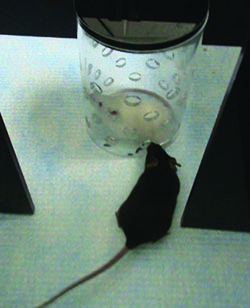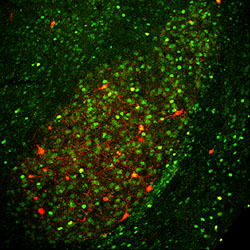Brodkin Lab Research
Research Interests
Developmental neurobiology and genetics of social behaviors, including social affiliative and aggressive behaviors, in mouse models relevant to autism and schizophrenia spectrum disorders.
Research Summary
Our laboratory is interested in the neurobiological and genetic mechanisms of social behavior development, particularly the development of social affiliative and aggressive behaviors. Certain highly heritable neuropsychiatric disorders, including autism and schizophrenia spectrum disorders, are characterized by disabling disruptions of socio-emotional behaviors (e.g. affiliative behaviors, aggressive behaviors) and social cognition. The fundamental biology of these social behaviors is not well understood, and currently available treatments for these social behavior symptoms are inadequate.
Our laboratory is focused on the following major questions of interest:
- What are the neurobiological mechanisms that underlie the tendency to seek or avoid affiliative social interactions?
- What are the neurobiological mechanisms that promote or inhibit the initiation of aggressive behaviors?
- What genes and environmental factors contribute to individual differences in sociability and aggressive behaviors?
- What genes and environmental factors contribute to the etiology and pathophysiology of "disorders of social relatedness," e.g. autism spectrum disorders or schizophrenia?
- How does the neural circuitry mediating social behaviors develop and function differently in autism spectrum disorders or schizophrenia?
Our studies of the biology of social behaviors use the mouse as a model organism, because of the experimental control that a model organism provides, and because of the many resources available for mouse genetics. For virtually every mouse gene, there is a homologous human gene, and vice versa. Moreover, the genetic and neurobiological pathways underlying basic social behaviors, such as affiliation and aggression, appear to have been conserved, to a substantial extent, across mammalian evolution. Thus, animal studies can help to elucidate neurobiological pathways and mechanisms that are involved in autism, schizophrenia, and other human neuropsychiatric disorders.
Mice and many other mammals rely heavily on olfactory information from conspecifics (pheromones and other odorants) to guide social interactions, whereas humans rely more heavily on visual and auditory information (facial expression and language). However in virtually all mammals, the emotional/motivational significance of this sensory information about the social world (the rewarding vs. aversive significance of social stimuli) is encoded, downstream, by the extended amygdala, hippocampus, bed nucleus of stria terminalis (BNST), various hypothalamic nuclei, nucleus accumbens, lateral septum, and frontal cortex. We are studying the role of these limbic circuits in social affiliative and aggressive behaviors, using mouse models.

Our current projects include the following: 1) Studies of the neural circuitry that mediates social behaviors, using immunohistochemical studies of immediate early genes expression and markers of glutamatergic and GABAergic neurons in mouse brain; 2) studies of social behavior phenotypes and structure/function of limbic circuitry mediating social behaviors in mice with spontaneous or induced mutations of autism or schizophrenia susceptibility genes, and pharmacologic studies aimed at rescuing social behaviors in these mouse models; 3) studies of gene-environment interactions in shaping social behavior development; 4) studies of the neurobiology of candidate genes in a genomic locus that affects aggressive behaviors in mice.
Techniques used in the lab include measurement of mouse social affiliative behaviors, aggressive behaviors, anxiety-related behaviors, and olfaction; behavioral genetics, genetic mapping, quantitative trait locus (QTL) analysis; behavioral and neurobiological studies of mice with spontaneous or induced mutations of autism- and schizophrenia susceptibility genes; immunohistochemistry studies of immediate early gene expression and expression of proteins relevant to glutamatergic and GABAergic neurotransmission; autoradiography; microarray analysis of gene expression; and behavioral pharmacology.

Back to Top
